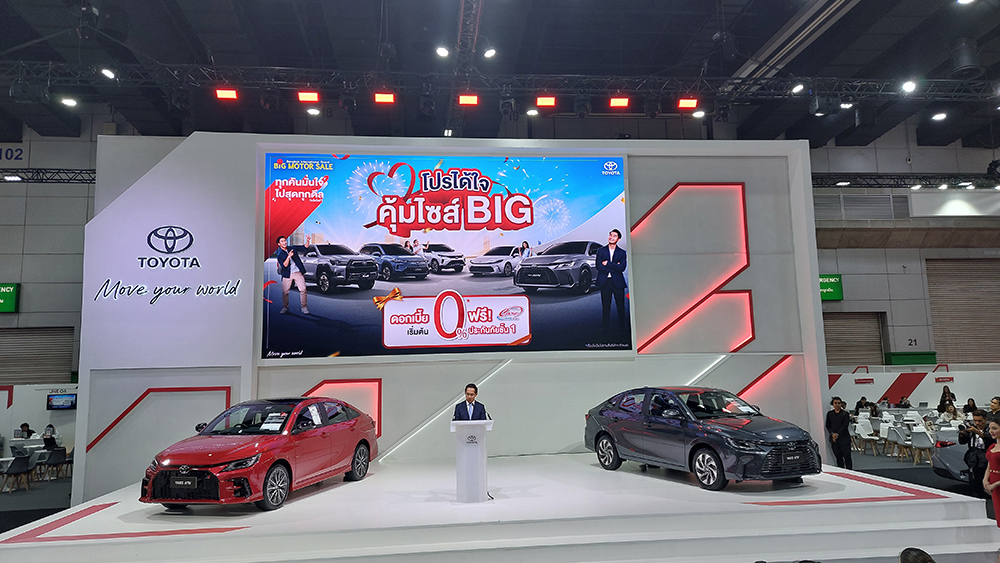
บริษัท โตโยต้า มอเตอร์ ประเทศไทย จำกัด แถลงสถิติการจำหน่ายรถยนต์ปี 2565 พร้อมคาดการณ์ตลาดรถยนต์ไทยปี 2566 เมื่อวันที่ 26 มกราคม 2566
สถิติการขายรถยนต์ในปี 2565
ปี 2565 ถือเป็นปีที่อุตสาหกรรมยานยนต์ของประเทศไทยยังอยู่ในภาวะการฟื้นตัวอย่างค่อยเป็นค่อยไป โดยมีปัจจัยบวกจากการดำเนินมาตรการกระตุ้นเศรษฐกิจอย่างต่อเนื่อง พร้อมนโยบายผ่อนคลายทางการเงินของภาครัฐ เพื่อช่วยสนับสนุนการฟื้นตัวของเศรษฐกิจภายในประเทศ และการส่งออกที่เริ่มเติบโตดีขึ้นตามการฟื้นตัวของเศรษฐกิจของประเทศคู่ค้าต่างๆ ตลอดจนสถานการณ์ของ COVID-19 ที่มีการผ่อนคลายมาตรการควบคุมการแพร่ระบาดภายในประเทศของภาครัฐ รวมถึงการทยอยฟื้นตัวของการท่องเที่ยวจากการเปิดประเทศ มีส่วนช่วยให้สถานการณ์เศรษฐกิจในประเทศเริ่มกลับเข้าสู่ภาวะปกติได้ดียิ่งขึ้น

อย่างไรก็ตาม ยังคงมีปัจจัยด้านลบอื่นๆ ที่ส่งผลกระทบอยู่อย่างต่อเนื่อง เช่นปัญหาการขาดแคลนเซมิคอนดัคเตอร์ที่ยังคงยืดเยื้อ ส่งผลกระทบกับภาคการผลิตในทุกอุตสาหกรรมยานยนต์ทั่วโลก รวมถึงไปปัจจัยอื่นๆ จากสถานการณ์เศรษฐกิจในภาพรวม อาทิ ปัญหาด้านโลจิสติกส์ระหว่างประเทศจากต้นทุนการขนส่งสินค้าทางเรืออยู่ในระดับสูง อัตราเงินเฟ้อที่เพิ่มขึ้นขณะที่เศรษฐกิจยังไม่ฟื้นตัวเต็มที่ ตลอดจนความผันผวนของสถานการณ์การเงินโลก ราคาพลังงาน และวัตถุดิบที่ปรับตัวสูงขึ้น ส่งผลโดยตรงต่อต้นทุนการผลิตรถยนต์เพื่อจำหน่ายทั้งภายในประเทศและการส่งออก รวมถึงส่งผลกระทบต่อการดำเนินธุรกิจและความเชื่อมั่นผู้บริโภคที่มีต่อเศรษฐกิจไทย แต่ในภาพรวมแล้วยังถือว่าการฟื้นตัวของอุตสาหกรรมยานยนต์ไทยเป็นไปในทิศทางที่ดีขึ้น ซึ่งสะท้อนมายังตลาดรถยนต์ในประเทศด้วยเช่นกัน โดยตัวเลขยอดขายรวมภายในประเทศปี 2565 อยู่ที่ 849,388 คัน หรือเพิ่มขึ้น 11.9% เมื่อเทียบกับปี 2564
สถิติการขายรถยนต์ในปี 2565 | ยอดขายปี 2565 | การเปลี่ยนแปลงเทียบกับปี 2564 |
ปริมาณการขายรวม | 849,388 คัน | +11.9% |
รถยนต์นั่ง | 265,069 คัน | +5.3% |
รถเพื่อการพาณิชย์ | 584,319 คัน | +15.2% |
รถกระบะ 1 ตัน (รวมรถกระบะดัดแปลง) | 454,875 คัน | +15.6% |
รถกระบะ 1 ตัน (ไม่รวมรถกระบะดัดแปลง) | 388,298 คัน | +13.7% |
สำหรับยอดขายของโตโยต้าในปี 2565 มียอดขายโดยรวมอยู่ที่ประมาณ 288,809 คัน หรือเพิ่มขึ้น 20.5% เมื่อเทียบกับปีที่ผ่านมา มีส่วนแบ่งทางการตลาดเป็นอันดับ 1 หรือเท่ากับ 34% ของยอดขายรถยนต์ทั้งหมด ส่วนหนึ่งเป็นผลมาจากการที่ส่วนแบ่งทางการตลาดรถยนต์นั่งของโตโยต้ามีการเติบโตสูงขึ้นจากปีที่แล้วอย่างเห็นได้ชัด โดยเฉพาะอย่างยิ่งกับความสำเร็จด้านยอดขายของรถยนต์รุ่นใหม่อย่าง Veloz และ Yaris ATIV ที่ได้รับการตอบรับจากลูกค้าเป็นอย่างดีภายหลังจากการแนะนำเข้าสู่ตลาดไปเมื่อปี 2565 รวมไปถึงการดำเนินกิจกรรมทางการตลาดในรูปแบบต่างๆ ตลอดจนผลิตภัณฑ์ยานยนต์ที่หลากหลาย สามารถเข้าถึงและใกล้ชิดกับลูกค้าในกลุ่มเป้าหมายต่างๆ ได้ดียิ่งขึ้นกว่าเดิม
สถิติการขายรถยนต์ของโตโยต้าในปี 2565 | ยอดขายปี 2565 | การเปลี่ยนแปลงเทียบกับปี 2564 | ส่วนแบ่งตลาด |
ปริมาณการขายโตโยต้า | 288,809 คัน | +20.5% | 34.0% |
รถยนต์นั่ง | 82,738 คัน | +32.6% | 31.2% |
รถเพื่อการพาณิชย์ | 206,071 คัน | +16.2% | 35.3% |
รถกระบะ 1 ตัน (รวมรถกระบะดัดแปลง) | 175,786 คัน | +16.0% | 38.6% |
รถกระบะ 1 ตัน (ไม่รวมรถกระบะดัดแปลง) | 148,101 คัน | +15.1% | 38.1% |

แนวโน้มอุตสาหกรรมยานยนต์ไทยในปี 2566
สำหรับแนวโน้มอุตสาหกรรมยานยนต์ไทยในปี 2566 คาดว่าจะยังคงกลับคืนสู่สภาวะปกติอย่างค่อยเป็นค่อยไปพร้อมๆ กับการฟื้นตัวของเศรษฐกิจโดยรวม จากทิศทางที่ดีในการลดระดับโควิด-19 สู่โรคติดต่อเฝ้าระวังของกระทรวงสาธารณสุข ส่งผลให้การดำเนินชีวิตผู้คนเริ่มกลับสู่สภาวะปกติ พร้อมกับการเปิดประเทศส่งเสริมการท่องเที่ยว ที่มีส่วนช่วยเพิ่มอุปสงค์ภายในประเทศ ในขณะที่ปัญหาการขาดแคลนชิ้นส่วนการผลิตก็จะค่อยๆ คลี่คลายลงเช่นกัน อันจะส่งผลให้อุตสาหกรรมยานยนต์เริ่มทยอยกลับคืนสู่สภาวะปกติ และคาดการณ์ว่ายอดขายรถยนต์ในปี 2566 จะอยู่ที่ 900,000 คัน หรือเพิ่มขึ้น 6.0% เมื่อเทียบกับปีที่แล้ว
ประมาณการยอดขายรถยนต์ในประเทศปี 2566 | ยอดขายประมาณการปี 2566 | เปลี่ยนแปลงเทียบกับปี 2565 |
ปริมาณการขายรวม | 900,000 คัน | + 6.0% |
รถยนต์นั่ง | 301,500 คัน | + 13.7% |
รถเพื่อการพาณิชย์ | 598,500 คัน | + 2.4% |
สำหรับโตโยต้า มีการตั้งเป้ายอดขายอยู่ที่ 310,000 คัน หรือเพิ่มขึ้น 7.3% โดยครองส่วนแบ่งทางการตลาดอยู่ที่ 34.4%
ประมาณการยอดขายรถยนต์ โตโยต้าในปี 2566 | ยอดขายประมาณการปี 2566 | เปลี่ยนแปลงเทียบกับปี 2565 | ส่วนแบ่งตลาด |
ปริมาณการขายโตโยต้า | 310,000 คัน | + 7.3% | 34.4% |
รถยนต์นั่ง | 96,900 คัน | + 17.1% | 32.1% |
รถเพื่อการพาณิชย์ | 213,100 คัน | + 3.4% | 35.6% |
รถกระบะ 1 ตัน (รวมรถกระบะดัดแปลง) | 183,000คัน | + 4.1% | 41.1% |
รถกระบะ 1 ตัน (ไม่รวมรถกระบะดัดแปลง) | 155,000 คัน | + 4.7% | 41.9% |
ปริมาณการส่งออกรถยนต์และการผลิตของโตโยต้าในปี 2565
ในด้านการส่งออกรถยนต์ ในปี 2565 โตโยต้าได้ส่งออกรถยนต์สำเร็จรูปไปจำนวน 378,454 คัน หรือเพิ่มขึ้น 30% จากปี 2564 โดยยอดรวมการผลิตรถยนต์สำหรับการขายภายในประเทศและการส่งออกในปี 2565 มีจำนวนทั้งสิ้น 659,262 คัน หรือเพิ่มขึ้น 28% จากปี 2564
ปริมาณการส่งออกรถยนต์สำเร็จรูปและการผลิตของ โตโยต้าในปี 2565 | ปริมาณในปี 2565 | เปลี่ยนแปลงเทียบกับปี 2564 |
ปริมาณการส่งออก | 378,454 คัน | + 30% |
ยอดผลิตรวมทั้งส่งออกและการขายในประเทศ | 659,262 คัน | + 28% |
เป้าหมายการส่งออกรถยนต์และการผลิตของโตโยต้าในปี 2566
สำหรับเป้าหมายการส่งออกรถยนต์สำเร็จรูปของโตโยต้าในปี 2566 ได้คาดการณ์ว่าความต้องการของตลาดต่างประเทศจะเพิ่มสูงขึ้น จากสถานการณ์การฟื้นตัวทางเศรษฐกิจของบรรดาประเทศคู่ค้าที่เป็นไปในทิศทางที่ดีขึ้น โดยโตโยต้าตั้งเป้าปริมาณการส่งออกรถยนต์อยู่ที่ 405,000 คัน หรือเพิ่มขึ้น 7% เมื่อเทียบกับปีที่ผ่านมา และได้ตั้งเป้าการผลิตรถยนต์ทั้งหมดของปี 2566 อยู่ที่ ราว 723,000 คัน หรือเพิ่มขึ้น 9.7% จากปีที่ผ่านมา
เป้าหมายการส่งออกรถยนต์สำเร็จรูปและการผลิตของโตโยต้าปี 2566 | ปริมาณในปี 2566 | เปลี่ยนแปลงเทียบกับปี 2565 |
ปริมาณการส่งออก | 405,000 คัน | + 7.0% |
ยอดผลิตรวมทั้งส่งออกและการขายในประเทศ | 723,000 คัน | + 9.7% |
ทิศทางการดำเนินธุรกิจของโตโยต้าในประเทศไทย ในปี 2566
ในปีนี้ โตโยต้าพร้อมเดินหน้าตามแนวทางที่ มร.อากิโอะ โตโยดะ กรรมการผู้จัดการใหญ่ และประธานคณะกรรมการบริหาร บริษัท โตโยต้า มอเตอร์ คอร์ปอเรชั่น ประเทศญี่ปุ่น ได้ประกาศเจตนารมณ์ไว้ในงานฉลองวาระครบรอบ 60 ปี ของบริษัท โตโยต้า มอเตอร์ ประเทศไทย จำกัด เมื่อช่วงปลายปีที่ผ่านมา ในการดำเนินงานเพื่อมุ่งสู่เป้าหมายการเป็น “ผู้นำพาการขับเคลื่อนสำหรับทุกคน” (Mobility for All) พร้อมสร้าง “ความเป็นกลางทางคาร์บอน” (Carbon Neutrality) ผ่านการเตรียมความพร้อมในหลากหลายแนวทาง หรือ “Multi – Pathway” เพื่อทุกความเป็นไปได้ที่จะช่วยลดการปล่อยก๊าซเรือนกระจกที่เกิดจากการเดินทางของผู้คนผ่านการนำเสนอผลิตภัณฑ์ การบริการ และ กิจกรรมต่างๆ เพื่อส่งมอบความสุขที่ยั่งยืนให้แก่ผู้คนและสังคมไทย

ในด้านผลิตภัณฑ์และการบริการสำหรับลูกค้า โตโยต้าจะพัฒนาเทคโนโลยียานยนต์ที่ขับเคลื่อนด้วยพลังงานไฟฟ้าและพลังงานทางเลือกต่างๆ เพื่อมอบทางเลือกที่เป็นมิตรต่อสิ่งแวดล้อมที่เป็นไปได้สำหรับทุกคน ควบคู่ไปกับการให้ความสำคัญกับการดำเนินกิจกรรมการตลาด และการส่งเสริมการขายภายใต้แนวคิด Closer to customer (ใกล้ชิดกับลูกค้ามากยิ่งขึ้น) ตลอดจนร่วมกับเครือข่ายทางธุรกิจในการนำเสนอนวัตกรรมหรือผลิตภัณฑ์เพื่อมอบประสบการณ์การเดินทางและการบริการที่ดียิ่งขึ้นให้แก่ลูกค้าอย่างสม่ำเสมอ อาทิ การผสมผสานเทคโนโลยีแห่งการเชื่อมต่อเพื่อสร้างความสะดวกสบายในการเดินทาง (Connected) การบริการการขับเคลื่อนในรูปแบบของการแบ่งปันการใช้งาน (Sharing) เป็นต้น

ในด้านสังคม โตโยต้ายังคงมุ่งเน้นการขับเคลื่อนสังคมไทย สู่ “ยุคแห่งการพัฒนาอย่างยั่งยืน” โดยการดำเนินงานในภาคส่วนต่างๆ พร้อมความร่วมมือกับพันธมิตรในอุตสาหกรรมอื่นๆ เพื่อมุ่งสู่เป้าหมายความเป็นกลางทางคาร์บอน (Carbon Neutrality) อาทิ เช่น
- โครงการพัฒนาเมืองต้นแบบที่ยั่งยืนปราศจากมลภาวะร่วมกับเมืองพัทยา ซึ่งที่ผ่านมาโตโยต้าได้มีการนำรถยนต์พลังงานสะอาดทุกรูปแบบไปทดลองให้บริการเพื่อตอบสนองการเดินทางที่มีความหลากหลายแก่ประชาชนและนักท่องเที่ยวในเมืองพัทยา โดยได้ร่วมมือกับโรงแรมและจุดท่องเที่ยวในตัวเมืองพัทยาเพื่อใช้เป็นจุดบริการรับรถและสถานีอัดประจุยานยนต์ไฟฟ้าสำหรับผู้ที่สนใจใช้บริการ และในปีนี้มีแผนที่ขยายผลความร่วมมือเพื่อให้สามารถรองรับการใช้งานที่หลากหลายและครอบคลุมพื้นที่ในตัวเมืองพัทยามากยิ่งขึ้นตลอดจนศึกษาความเป็นไปได้ในการขยายผลการดำเนินงานสู่ความร่วมมือในการบริการระบบขนส่งมวลชนภายในตัวเมืองพัทยาด้วยรถยนต์พลังงานทางเลือกอย่าง ไฮโดรเจน และ เซลส์เชื้อเพลิง พร้อมทั้งแผนการขยายการดำเนินงานไปยังพื้นที่ของจังหวัดอื่นๆต่อไปในอนาคต
- โครงการความร่วมมือกับเครือเจริญโภคภัณฑ์ (ซีพี) ในการร่วมมือศึกษาแนวทางในการลดมลพิษจากการโลจิสติกส์ขนส่งสินค้าด้วยเทคโนโลยีที่ปล่อยมลพิษเป็นศูนย์อย่างรถบรรทุกที่ใช้พลังงานจากเซลส์เชื้อเพลิง ตลอดจนแนวทางการผลิตไฮโดรเจนพลังงานสะอาดจากชีวมวล
- การขยายผลการดำเนินงานของโครงการ “ชุมชนสิ่งแวดล้อมยั่งยืน เพื่อมุ่งสู่ความเป็นกลางทางคาร์บอน” ซึ่งเป็นการยกระดับจากการสร้างศูนย์การเรียนรู้ จากโครงการ “โตโยต้า เมืองสีเขียว อยุธยา” ไปสู่การสร้างชุมชนต้นแบบที่จะสร้างจิตสำนึกด้านสิ่งแวดล้อมให้ทุกคนในชุมชนสามารถอยู่ร่วมกับธรรมชาติได้อย่างยั่งยืน โดยในปีที่ผ่านมาได้มีการเปิดชุมชนต้นแบบแห่งแรกไปแล้วที่จังหวัดระยอง และในปีนี้ โตโยต้าได้ตั้งเป้าหมายที่จะขยายเพิ่มให้ครอบคลุมทุกภูมิภาคทั่วประเทศ
- โตโยต้าจะยังคงแสวงหาแนวทางการประสานความร่วมมือกับองค์กรพันธมิตรในอุตสาหกรรมต่างๆที่มีเป้าหมายเดียวกัน เพื่อมีส่วนช่วยผลักดันในการบรรลุเป้าหมายการพัฒนาอย่างยั่งยืนของเศรษฐกิจและสังคมไทยต่อไป

โตโยต้า ร่วมขับเคลื่อนอนาคต
สถิติการจำหน่ายรถยนต์ เดือนธันวาคม 2565
- ตลาดรถยนต์รวม ปริมาณการขาย 82,799 คัน ลดลง 0%
อันดับที่ 1 โตโยต้า 30,197 คัน เพิ่มขึ้น 11.2% ส่วนแบ่งตลาด 36.5%
อันดับที่ 2 อีซูซุ 18,216 คัน ลดลง 3.1% ส่วนแบ่งตลาด 22.0%
อันดับที่ 3 ฮอนด้า 8,324 คัน ลดลง 28.0% ส่วนแบ่งตลาด 10.1%
- ตลาดรถยนต์นั่ง ปริมาณการขาย 24,698 คัน ลดลง6%
อันดับที่ 1 โตโยต้า 8,941 คัน เพิ่มขึ้น 21.7 % ส่วนแบ่งตลาด 36.2%
อันดับที่ 2 ฮอนด้า 5,786 คัน ลดลง 34.0% ส่วนแบ่งตลาด 23.4%
อันดับที่ 3 มิตซูบิชิ 1,824 คัน ลดลง 26.6% ส่วนแบ่งตลาด 7.4%
- ตลาดรถเพื่อการพาณิชย์ ปริมาณการขาย 58,101 คัน ลดลง7%
อันดับที่ 1 โตโยต้า 21,256 คัน เพิ่มขึ้น 7.3% ส่วนแบ่งตลาด 36.6%
อันดับที่ 2 อีซูซุ 18,216 คัน ลดลง 3.1% ส่วนแบ่งตลาด 31.4%
อันดับที่ 3 ฟอร์ด 5,543 คัน เพิ่มขึ้น 34.6% ส่วนแบ่งตลาด 9.5%
- ตลาดรถกระบะขนาด 1 ตัน (Pure Pick up และ รถกระบะดัดแปลง PPV*)
ปริมาณการขาย 43,322 คัน เพิ่มขึ้น 1.3%
อันดับที่ 1 โตโยต้า 18,083 คัน เพิ่มขึ้น 8.1% ส่วนแบ่งตลาด 41.7%
อันดับที่ 2 อีซูซุ 16,638 คัน ลดลง 1.6% ส่วนแบ่งตลาด 38.4%
อันดับที่ 3 ฟอร์ด 5,543 คัน เพิ่มขึ้น 34.6% ส่วนแบ่งตลาด 12.8%
*ปริมาณการขายรถกระบะดัดแปลง (ในตลาดรถกระบะขนาด 1 ตัน) 7,831 คัน
อีซูซุ 2,769 คัน – โตโยต้า 2,758 คัน – ฟอร์ด 1,565 คัน – มิตซูบิชิ 619 คัน – นิสสัน 120 คัน
- ตลาดรถกระบะ Pure Pick up ปริมาณการขาย 35,491 คัน ลดลง 8%
อันดับที่ 1 โตโยต้า 15,325 คัน เพิ่มขึ้น 7.4% ส่วนแบ่งตลาด 43.2%
อันดับที่ 2 อีซูซุ 13,869 คัน ลดลง 7.0% ส่วนแบ่งตลาด 39.1%
อันดับที่ 3 ฟอร์ด 3,978 คัน เพิ่มขึ้น 16.7% ส่วนแบ่งตลาด 11.2%
- สถิติการจำหน่ายรถยนต์ เดือนมกราคม – ธันวาคม 2565
- ตลาดรถยนต์รวม ปริมาณการขาย 849,388 คัน เพิ่มขึ้น 9%
อันดับที่ 1 โตโยต้า 288,809 คัน เพิ่มขึ้น 20.5 % ส่วนแบ่งตลาด 34.0%
อันดับที่ 2 อีซูซุ 212,491 คัน เพิ่มขึ้น 15.4% ส่วนแบ่งตลาด 25.0%
อันดับที่ 3 ฮอนด้า 82,842 คัน ลดลง 6.6% ส่วนแบ่งตลาด 9.8%
- ตลาดรถยนต์นั่ง ปริมาณการขาย 265,069 คัน เพิ่มขึ้น 3%
อันดับที่ 1 โตโยต้า 82,738 คัน เพิ่มขึ้น 32.6% ส่วนแบ่งตลาด 31.2%
อันดับที่ 2 ฮอนด้า 61,665 คัน ลดลง 19.8% ส่วนแบ่งตลาด 23.3%
อันดับที่ 3 มิตซูบิชิ 21,157 คัน เพิ่มขึ้น 14.6% ส่วนแบ่งตลาด 8.0%
- ตลาดรถเพื่อการพาณิชย์ ปริมาณการขาย 584,319 คัน เพิ่มขึ้น 2%
อันดับที่ 1 อีซูซุ 212,491 คัน เพิ่มขึ้น 15.4% ส่วนแบ่งตลาด 36.4%
อันดับที่ 2 โตโยต้า 206,071 คัน เพิ่มขึ้น 16.2% ส่วนแบ่งตลาด 35.3%
อันดับที่ 3 ฟอร์ด 43,582 คัน เพิ่มขึ้น 34.8% ส่วนแบ่งตลาด 7.5%
- ตลาดรถกระบะขนาด 1 ตัน (Pure Pick up และ รถกระบะดัดแปลง PPV*) ปริมาณการขาย 454,875 คัน เพิ่มขึ้น 15.6%
อันดับที่ 1 อีซูซุ 195,945 คัน เพิ่มขึ้น 17.2% ส่วนแบ่งตลาด 43.1%
อันดับที่ 2 โตโยต้า 175,786 คัน เพิ่มขึ้น 16.0% ส่วนแบ่งตลาด 38.6%
อันดับที่ 3 ฟอร์ด 43,582 คัน เพิ่มขึ้น 34.8% ส่วนแบ่งตลาด 9.6%
*ปริมาณการขายรถกระบะดัดแปลง (ในตลาดรถกระบะขนาด 1 ตัน) 66,577 คัน
โตโยต้า 27,685 คัน – อีซูซุ 20,520 คัน – ฟอร์ด 9,765 คัน – มิตซูบิชิ 7,405 คัน – นิสสัน 1,202 คัน
- ตลาดรถกระบะ Pure Pick up ปริมาณการขาย 388,298 คัน เพิ่มขึ้น 7%
อันดับที่ 1 อีซูซุ 175,425 คัน เพิ่มขึ้น 16.4% ส่วนแบ่งตลาด 45.2%
อันดับที่ 2 โตโยต้า 148,101 คัน เพิ่มขึ้น 15.1% ส่วนแบ่งตลาด 38.1%
อันดับที่ 3 ฟอร์ด 33,817 คัน เพิ่มขึ้น 23.9% ส่วนแบ่งตลาด 8.7%
Toyota Thailand announces their 2022 Car Sales along with 2023 Domestic Market Projection at 900,000 Units and 2023 Toyota Sales Target at 310,000 Units
Toyota Motor Thailand Co., Ltd. announced their 2022 car sales performance along with the Thai automotive market projection in 2023 in their Toyota Annual Press Conference held on 26 January 2023.
Automotive Market Performance in 2022
The automotive industry in Thailand exhibited signs of gradually being on the process of recovering in 2022. Indeed, there were positive contributing factors from ongoing economic stimulus measures, as well as the government’s financial relaxation policy, to support the domestic economy’s recovery. Exports that begin to grow in tandem with the economic recovery of business partners were another factor supporting the turnaround of the Thai automotive industry. Additionally, the government’s easing of domestic control measures for COVID-19, along with the gradual and steady rebound of tourism following the opening of the country contribute to the country’s entire economic situation steady return to normalcy.

However, certain negative factors continue to have an impact on the recovery. For example, the global semiconductor shortage still affects manufacturing among all industries across the world. As a matter of fact, other factors relating to the overall economic situation including the international logistics issues caused by the high cost of ship transportation, the increased inflation despite the economy not yet completely having recovered, the volatility of global financial situation, and the rising prices of energy and raw materials. Obviously, these aforementioned factors have a direct impact on the cost of automobile production for both domestic and export sales as well as business operations and consumer confidence in the Thai economy. Nevertheless, it is still believed that the Thai automotive industry is currently on the path to recovery, which is also reflected in the domestic car market. Essentially, the overall domestic market volume in 2022 was 849,388 units, representing an 11.9% increase over 2021.
2022 Market Performance | 2022 Sales | Difference compared to 2021 |
Total Sales | 849,388 units | +11.9% |
Passenger Cars | 265,069 units | +5.3% |
Commercial Vehicles | 584,319 units | +15.2% |
1-ton Pickups (Including PPV) | 454,875 units | +15.6% |
Pure Pickups | 388,298 units | +13.7% |
In terms of Toyota performance in 2022, the total sales volume was 288,809 units, up 20.5% from the previous year. Toyota retained the No.1 market share, which is equivalent to 34% of all car sales. This was partially caused by Toyota’s increased market share in passenger cars from the previous year. Customers have particularly taken to the new Veloz and Yaris ATIV since the two models have been launched to the Thai market last year, resulting in their highly successful sales performance. Plus, Toyota’s outstanding performance in 2022 was largely attributed to the company’s use of a variety of marketing strategies and attractive products line up that efficiently allowed Toyota to better reach and connect with its diverse groups of customers and target audiences.
2022 Toyota Sales performance | 2022 Sales | Difference compared to 2021 | Market Share |
Total Sales | 288,809 units | +20.5% | 34.0% |
Passenger Cars | 82,738 units | +32.6% | 31.2% |
Commercial Vehicles | 206,071 units | +16.2% | 35.3% |
1-ton Pickups (Including PPV) | 175,786 units | +16.0% | 38.6% |
Pure Pickups | 148,101 units | +15.1% | 38.1% |
Automotive Market Outlook for 2023
For the 2023 automotive market outlook, it is anticipated that the automotive market will gradually return to normalcy along with the country’s overall economic recovery. In addition, the opening of the country to promote tourism contributes to increase domestic demand, while the shortage of production parts is expected to gradually ease. As a result of all these favorable aspects, the automotive sector will eventually return to normal circumstances, and it is expected that the market volume in 2023 will be 900,000 units, or 6.0% increase from last year.
2023 Domestic Sales Forecast | 2023 Sales Projection
| Difference compared to 2022 |
Total Sales | 900,000 units | + 6.0% |
Passenger Cars | 301,500 units | + 13.7% |
Commercial Vehicles | 598,500 units | + 2.4% |
As for Toyota, the sales target is set at 310,000 units, or a 7.3% increase, with 34.4% market share.
2023 Toyota Car Sales Forecast | 2023 Sales Forecast | Difference compared to 2022 | Market Share |
Total Sales | 310,000 units | + 7.3% | 34.4% |
Passenger Cars | 96,900 units | + 17.1% | 32.1% |
Commercial Vehicles | 213,100 units | + 3.4% | 35.6% |
1-ton Pickups (Including PPV) | 183,000 units | + 4.1% | 41.1% |
Pure Pickups | 155,000 units | + 4.7% | 41.9% |

Toyota Export and Production result in 2022
In terms of export, Toyota’s CBU export volume in 2022 was 378,454 units, or a 30% increase from 2021. Toyota’s total production volume for domestic sales and export in 2022 was 659,262 units, or a 28% increase from 2021.
Toyota CBU Export and Production Volume in 2022 | 2022 Performance | Difference compared to 2021 |
Export Volume | 378,454 units | + 30% |
Total Production Volume for Domestic Sales and Export | 659,262 units | + 28% |

Toyota Export and Production Outlook for 2023
Regarding the forecast of Toyota CBU exports in 2023, it is expected that the demand from overseas market will increase following the economic recovery in many of the countries of Toyota Thailand’s business partners. Therefore, Toyota target is set at 405,000 units, or a 7% increase over last year. In addition, our target of total production volume in 2023 will be around 723,000 units, or an 9.7% increase over last year.
Target of Toyota CBU Export and Production Volume in 2023 | 2023 Target | Difference compared to 2022 |
Export Volume | 405,000 units | + 7.0% |
Total Production Volume for Domestic Sales and Export | 723,000 units | + 9.7% |

Toyota’s future business direction in Thailand in 2023
This year, Toyota is ready to actively move forward in accordance with the direction set by Global President and CEO, Akio Toyoda, and announced in Toyota’s 60th Anniversary Celebration hosted at the end of last year. Toyota is committed to operating business while ensuring that the company aims for the goals of achieving “Economic Development” through “Mobility for All” and “Carbon Neutrality” through the “Multi-Pathway” approach to help reduce greenhouse gas emissions, through a variety of product and service offerings along with several activities to deliver happiness and mobility for all to the Thai people and society.
In terms of products and services for customer, Toyota will develop technologies for electrified vehicles and alternative fuel vehicles in a bid to offer everyone the greenest option possible that meets their personal mobility needs, while also emphasizing marketing initiatives and sales campaigns that adhere to the iconic “Closer to Customer” concept. Besides, Toyota will collaborate with business networks to continuously provide customers with leading-edge innovations and products that will enhance their mobility experiences and services, such as incorporating connected technologies to facilitate and enhance their travels (Connected), providing mobility services through car sharing (Shared), and so on. This is in line with the CASE (Connected, Autonomous, Shared, Electrified) paradigm shift that is transforming the automotive business to a mobility business.
For society, Toyota continues to focus on driving the Thai society toward the “Era of Sustainable Development” by working in multiple areas and collaborating with partners in other industries to ultimately achieve carbon neutrality, for instance:
- Decarbonized Sustainable City in Collaboration with Pattaya City
So far, Toyota has utilized all electrified vehicles i.e. ICE, HEV, BEV, FCEV to provide service and cater to various travel needs of locals and visitors to Pattaya. Toyota has worked together with hotels and popular tourist destinations in downtown Pattaya to utilize the vehicles as car pickup locations and electric vehicle charging stations for individuals interested in enjoying the service. In addition, this year, there are plans to expand the collaboration to support more via applications and include more locations in the Pattaya City, as well as to explore the possibility of building on the successful outcomes of last year to further develop collaborations with mass transit system service within Pattaya City with alternative energy vehicles that utilize hydrogen and fuel cells, as well as more future collaboration projects in other provinces.
- Collaborative Project with Charoen Pokphan Group (CP)
Toyota and CP will partner to research strategies to minimize emissions from transport logistics utilizing low or zero-emissions technologies, such as a fuel cell-powered trucks, while also exploring various state-of-the-art strategies for generating clean hydrogen from biomass.
- Expanding the operations of the “Sustainable Environment Communities for Carbon Neutrality” Project which reflects Toyota’s initiative to enhance the company’s contribution to the environment from the previously rolled out “Toyota Green Town” learning centers to further establishing role model communities that will raise awareness of environmental issues so that everyone can live in harmony with the nature on a sustainable basis. The first model community was founded last year in the province of Rayong. And, this year, Toyota has set a goal to extend the initiative, spanning every region of the country.
- Toyota Thailand looks forward to working with all likeminded stakeholders in Thailand to deliver for the development of the country in a sustainable manner.
Move Your World
Domestic Car Sales of December 2022
- Total Car Sales: 82,799 units, decrease by 0%
Number 1 Toyota 30,197 units 11.2% increase 36.5% market share
Number 2 Isuzu 18,216 units 3.1% decrease 22.0% market share
Number 3 Mitsubishi 8,324 units 28.0% decrease 10.1% market share
- Passenger Car Sales: 19,598 units, decrease by 6%
Number 1 Toyota 8,941 units 21.7 % increase 36.2% market share
Number 2 Honda 5,786 units 34.0% decrease 23.4% market share
Number 3 Mitsubishi 1,824 units 26.6% decrease 7.4% market share
- Commercial Vehicle Sales: 58,101 units, decrease by 7%
Number 1 Toyota 21,256 units 7.3% increase 36.6% market share
Number 2 Isuzu 18,216 units 3.1% decrease 31.4% market share
Number 3 Ford 5,543 units 34.6% increase 9.5% market share
- One-ton Pickups (Pure Pickup and PPV): 43,322 units, increase by 1.3%
Number 1 Toyota 18,083 units 8.1% increase 41.7% market share
Number 2 Isuzu 16,638 units 1.6% decrease 38.4% market share
Number 3 Ford 5,543 units 34.6% increase 12.8% market share
PPV sales in 1-ton pickup market: 7,831 units
Isuzu 2,769 units – Toyota 2,758 units – Ford 1,565 units – Mitsubishi 619 units – Nissan 120 units
5.) Pure Pickup Sales: 35,491 units, decrease by 2.8%
Number 1 Toyota 15,325 units 7.4% increase 43.2% market share
Number 2 Isuzu 13,869 units 7.0% decrease 39.1% market share
Number 3 Ford 3,978 units 16.7% increase 11.2% market share
- Domestic Car Sales of January – December 2022
1.) Total Car Sales: 849,388 units, increase by 11.9%
Number 1 Toyota 288,809 units 20.5 % increase 34.0% market share
Number 2 Isuzu 212,491 units 15.4% increase 25.0% market share
Number 3 Honda 82,842 units 6.6% decrease 9.8% market share
2.) Passenger Car Sales: 265,069 units, increase by 5.3%
Number 1 Toyota 82,738 units 32.6% increase 31.2% market share
Number 2 Honda 61,665 units 19.8% decrease 23.3% market share
Number 3 Mitsubishi 21,157 units 14.6% increase 8.0% market share
3.) Commercial Vehicle Sales: 584,319 units, increase by 15.2%
Number 1 Isuzu 212,491 units 15.4% increase 36.4% market share
Number2Toyota 206,071 units 16.2% increase 35.3% market share
Number3 Ford 43,582 units 34.8% increase 7.5% market share
4.) One-ton Pickup Sales (Pure Pick up and PPV): 454,875 units, increase by 15.6%
Number 1 Isuzu 195,945 units 17.2% increase 43.1% market share
Number 2 Toyota 175,786 units 16.0% increase 38.6% market share
Number 3 Ford 43,582 units 34.8% increase 9.6% market share
PPV sales in 1-ton pickup market: 66,577 units
Toyota 27,685 units – Isuzu 20,520 units – Ford 9,765 units – Mitsubishi 7,405 units – Nissan 1,202 units
5.) Pure Pickup Sales: 388,298 units, increase by 13.7%
Number 1 Isuzu 175,425 units 16.4% increase 45.2% market share
Number2 Toyota 148,101 units 15.1% increase 38.1% market share
Number3 Ford 33,817 units 23.9% increase 8.7% market share







